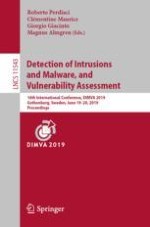2019 | Buch
Detection of Intrusions and Malware, and Vulnerability Assessment
16th International Conference, DIMVA 2019, Gothenburg, Sweden, June 19–20, 2019, Proceedings
herausgegeben von: Roberto Perdisci, Clémentine Maurice, Giorgio Giacinto, Dr. Magnus Almgren
Verlag: Springer International Publishing
Buchreihe : Lecture Notes in Computer Science
